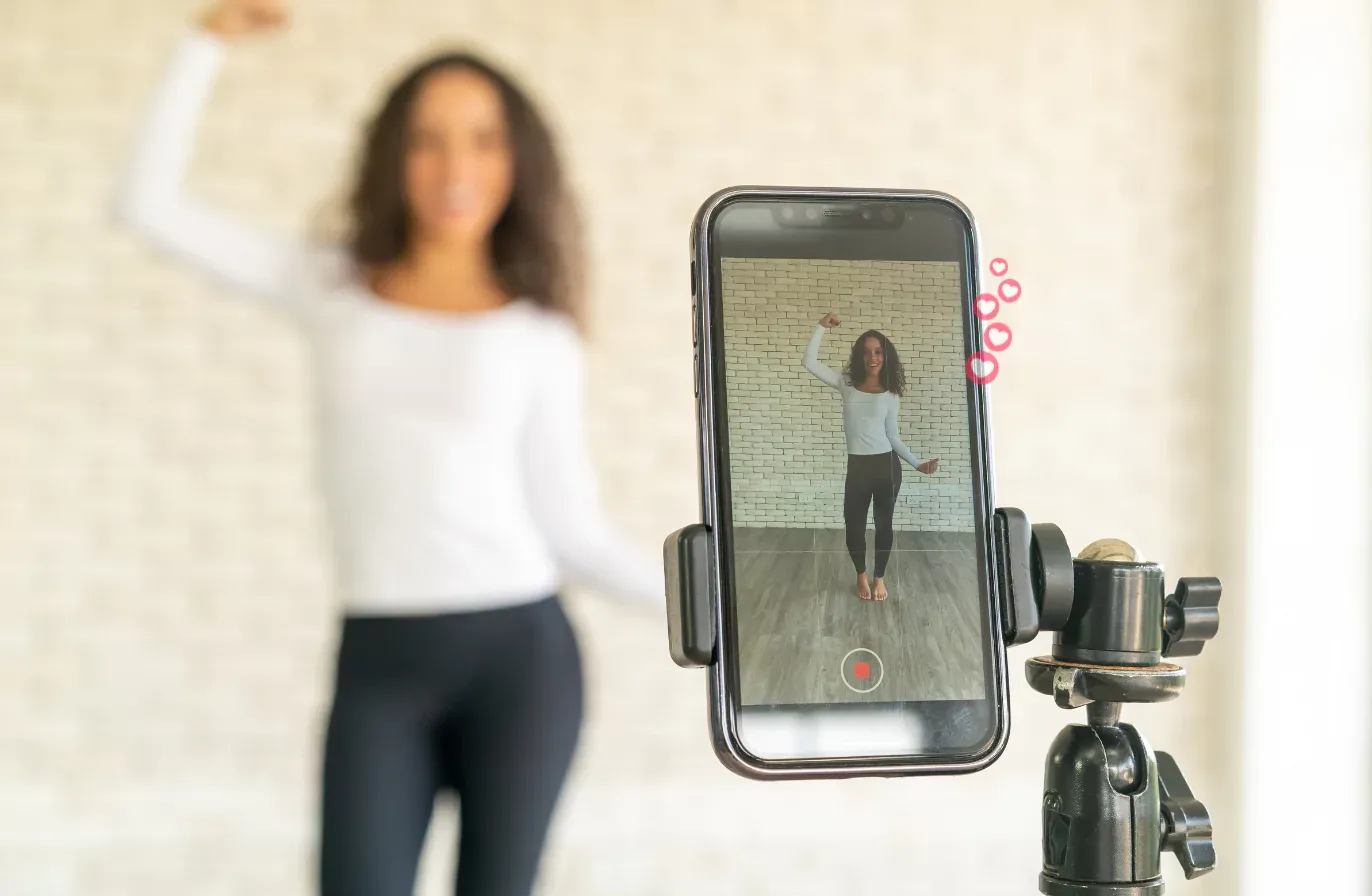How to Run a TikTok Audit For Your Brand
See what to include in a TikTok audit to evaluate your account and its performance and to identify improvement opportunities.

Imagine this: you’ve been posting on TikTok for weeks. A few videos explode with views, while others barely register. You start asking yourself: what’s driving the difference?
That’s where a TikTok audit steps in. It’s your chance to pause, review TikTok metrics, and uncover patterns about your audience, content, and overall strategy.
I’ve run these audits myself, and the insights are game-changing. From discovering hidden wins in overlooked posts to realizing my timing was off, every audit has reshaped my approach. In this guide, I’ll walk you through the exact steps to run a TikTok audit and show you which TikTok analytics can help you grow with clarity.
Key takeaways
-
Set a clear audit goal (growth, engagement, conversions, awareness)
-
Track core metrics related to your goal: views, reach, engagement rate, follower growth, watch time, traffic sources
-
Audit content performance: identify top/bottom posts, spot repeatable patterns, fix weak formats
-
Categorize content themes and double down on high-performing pillars
-
Check posting cadence & timing to match audience activity
-
Analyze engagement types (saves, shares, comments) to refine CTAs
-
Audit audience demographics to ensure alignment with your target market
-
Benchmark competitors: compare content mix, posting frequency, and engagement
-
Evaluate influencer partnerships and reinvest only in impactful ones
-
Turn insights into action: separate quick wins from big bets, test 2–3 experiments at a time
-
Document findings into a TikTok playbook for consistency
-
Run audits regularly (quarterly for strategy, monthly for campaigns)
What is a TikTok audit?
A TikTok audit is the process of reviewing your company’s overall account and how it is performing on different fronts like audience, content, and metrics like engagement.
The goal is to uncover what’s working, what isn’t, and where you can optimize to refine your strategy and grow more effectively.
Some of the aspects it covers are:
- Profile health
- Content performance
- Audience insights
- Posting cadence
- Engagement quality
- Competitor evaluation
Want to get a TikTok audit for your brand for free? Check out our free TikTok audit tool.
Why run a TikTok audit?
According to Statista, TikTok has over 33 million social buyers in the U.S.
To reach and influence this audience, brands need more than just a presence. They need a strategy that works.
Running a TikTok audit helps you track performance, understand what resonates, and refine your approach so your content can actually drive those buying decisions.
Here are other key reasons we recommend running an audit.
Stay trend relevant
Everything on TikTok moves fast. That audio everyone was using last week? It could already feel outdated.
A TikTok audit keeps you grounded, showing whether your content is actually riding the right waves.
It also helps you separate quick fads from meaningful trends that align with your brand. Instead of chasing every viral sound, your team can double down on the ones that spark real engagement and contribute to business results.
Understand how your audience interacts and engages
Every audience behaves differently. Some love sharing content, others prefer commenting or saving for later. An audit lets you see how your followers engage with your posts, not just whether they hit the like button.
You can even track your competitors’ posts to understand if your audience interacts with them in a different way. Do they comment more on their content as compared to just liking your posts? Do they leave more insightful comments? By analyzing this, you’ll uncover what changes you need to make to spark deeper engagement.
Validate content strategy
Experimenting with a lot of content pillars? Which of them is working the best? This is what a TikTok content audit helps you answer.
And the surprising thing is, sometimes the content pillars you think won’t work bring the most engagement.
For example, if engagement is low on your ‘salesy’ posts but higher on entertaining or behind-the-scenes clips, you can mix in more of that entertaining content to keep your audience hooked while still weaving in subtle brand messaging that drives them toward your goals.
Discover successful partnerships
Partnering with the right influencer can get you more eyeballs on a specific campaign. For example, if you’re launching a new product, a word from the right person can amplify product demand.
Review your partnership outcomes and collaborations to see which influencers are worth reinvesting in and which collaborations to skip. This ensures your resources go into building relationships that truly move the needle.
How to conduct a TikTok audit: A step-by-step process
Instead of haphazardly auditing different aspects of your TikTok marketing strategy, here are 6 TikTok audit steps to get clear insights in a structured way.
Step 1: Define your audit goal
There are hundreds of TikTok performance metrics you can measure, dozens of strategies you could tweak, and countless audience insights to dig into.
Realistically, you don’t need to chase all of them at once. That’s why, before even starting with your audit, we recommend defining your goal.
It could be:
- Growing your follower base with the right audience
- Increasing brand awareness
- Improving engagement quality (shares, saves, comments)
- Driving traffic or conversions from TikTok
- Benchmarking your performance against competitors
Once you finalize your goal, it becomes much easier to decide what to measure and how to go about it.
Sam Gillies, chief content officer at Nonsensical, a TikTok marketing agency, talks about the same
Ultimately, everything should tie back to your business goals. Virality doesn’t need to be the end goal for most accounts, though it’s certainly a bonus.
The key is understanding why you’re on TikTok in the first place. What business challenge is TikTok, or social media more broadly, meant to help solve? Every insight from the audit should connect to that — whether it’s awareness, consideration, community, or sales.
If your ‘why’ is unclear, your content and your metrics will be just as vague.
For example, let’s say your goal is to drive conversions. During the audit, you’d pay closer attention to metrics like profile views, bio link clicks, and traffic source types. On the other hand, if your main goal is brand awareness, you’d focus on reach, video views, and follower demographics.
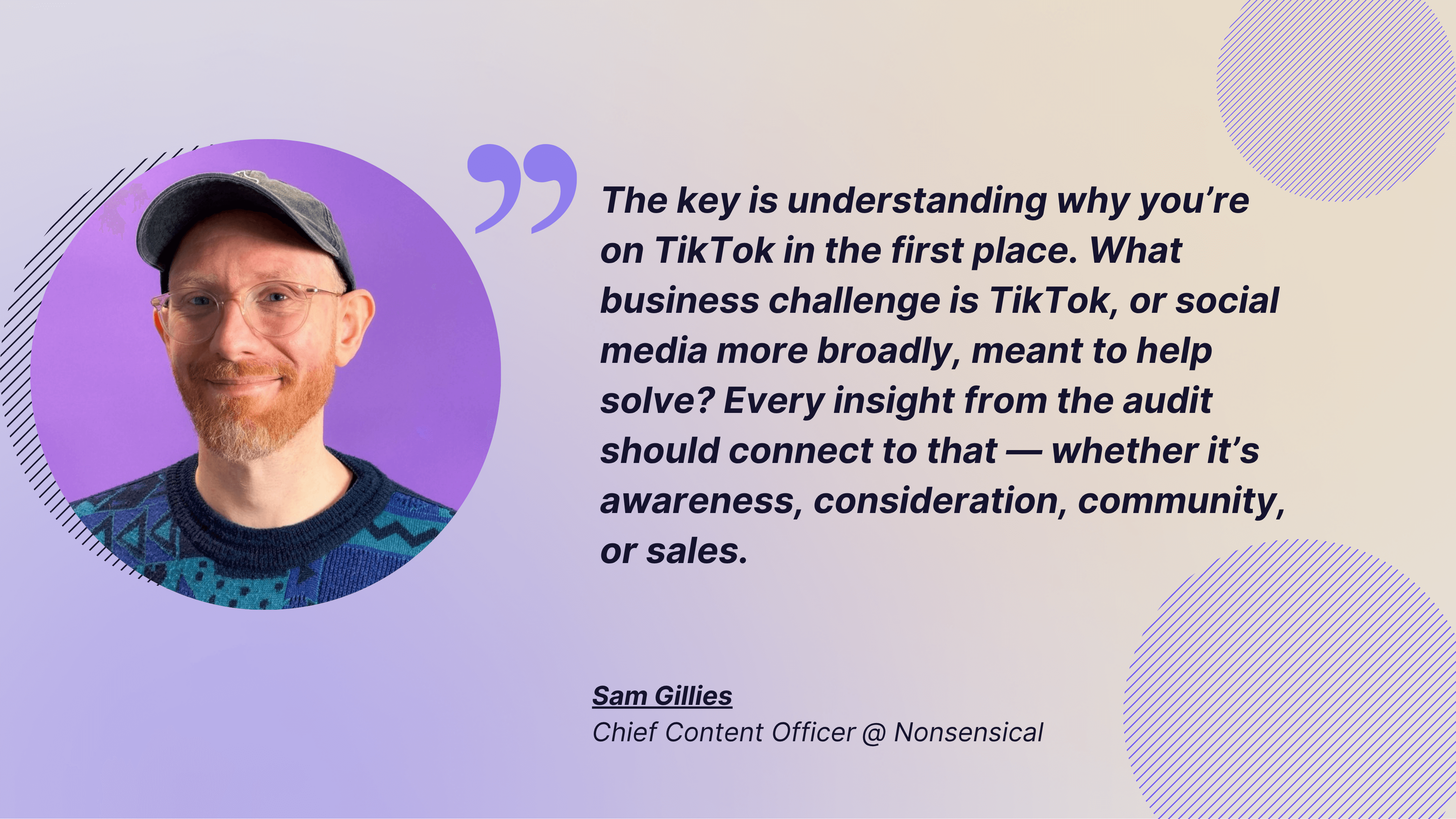
Step 2: Get an overview of your account performance with TikTok metrics
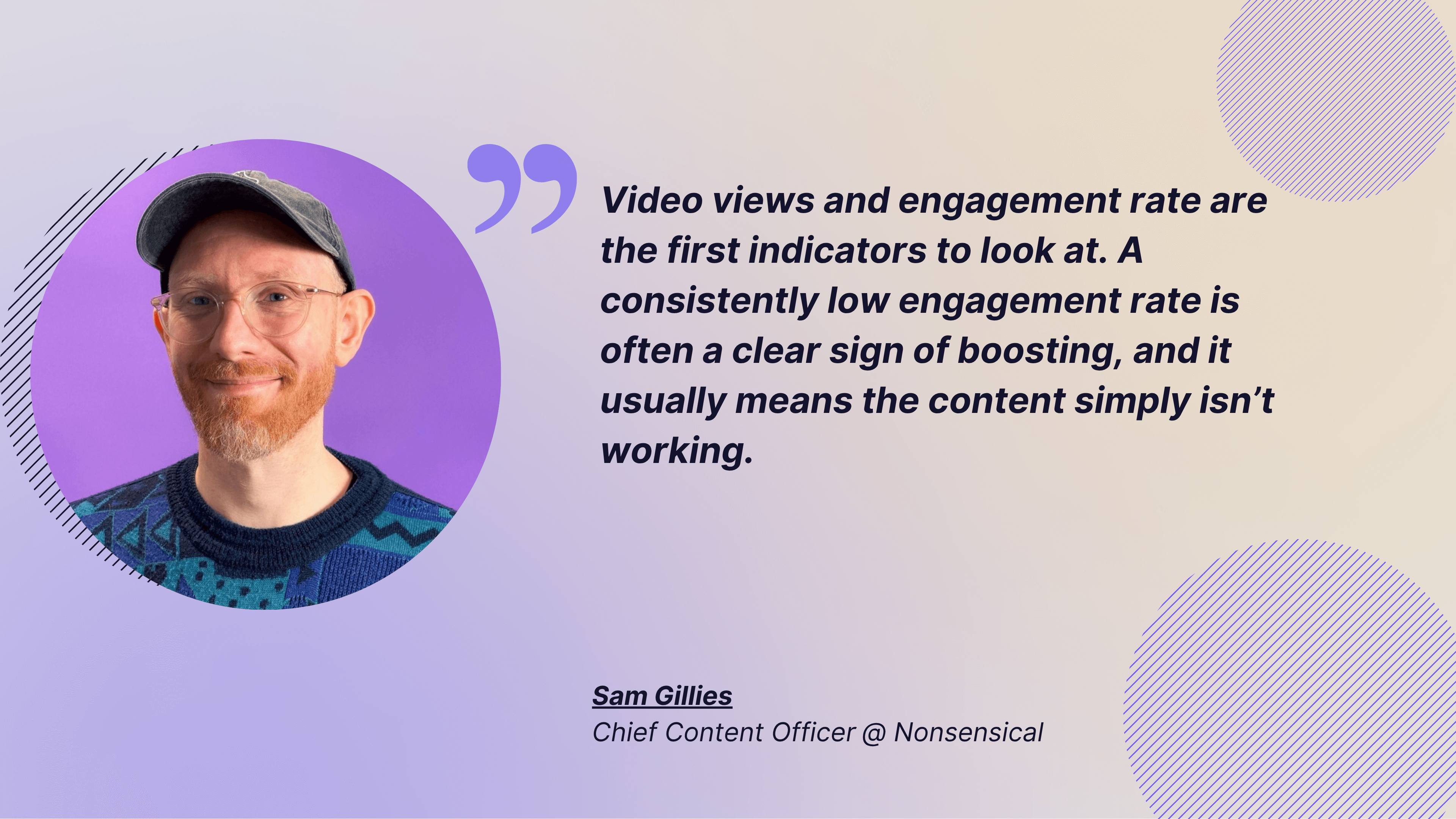
Before you dig deep into specific aspects of your TikTok strategy, here are the key metrics we start with while conducting an audit.
- Total views: This shows you how many times your videos have been watched. Tracking views gives you a sense of your overall reach and whether your content is consistently getting picked up by the TikTok algorithm.
I generally use Socialinsider to track if views have been steadily growing for my account.
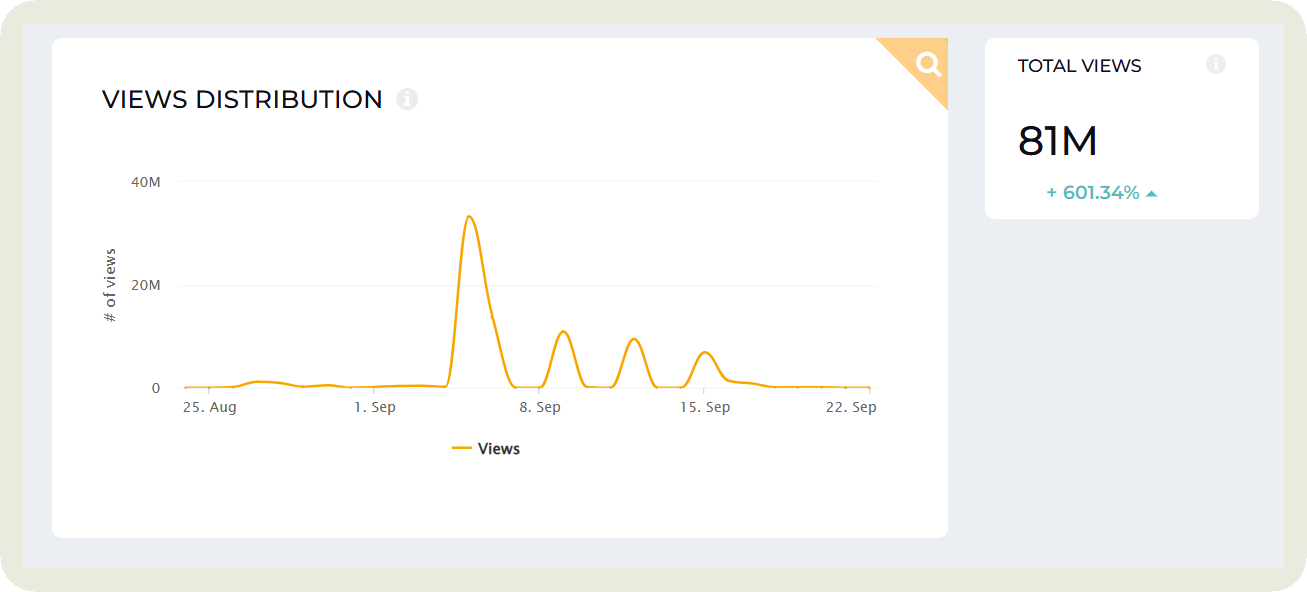
- Reach: Unlike total views (which can include repeat viewers), reach tells you how many unique people saw your content. This is crucial for measuring brand awareness and making sure your videos are expanding beyond your existing followers.
- Engagement rate: On TikTok, engagement rate is usually calculated by views: (likes + comments + shares + saves) ÷ views. This shows how engaging your videos are once people watch them.
Instead of manually calculating, I enter the relevant period on Socialinsider and let it give me the numbers in an instant.
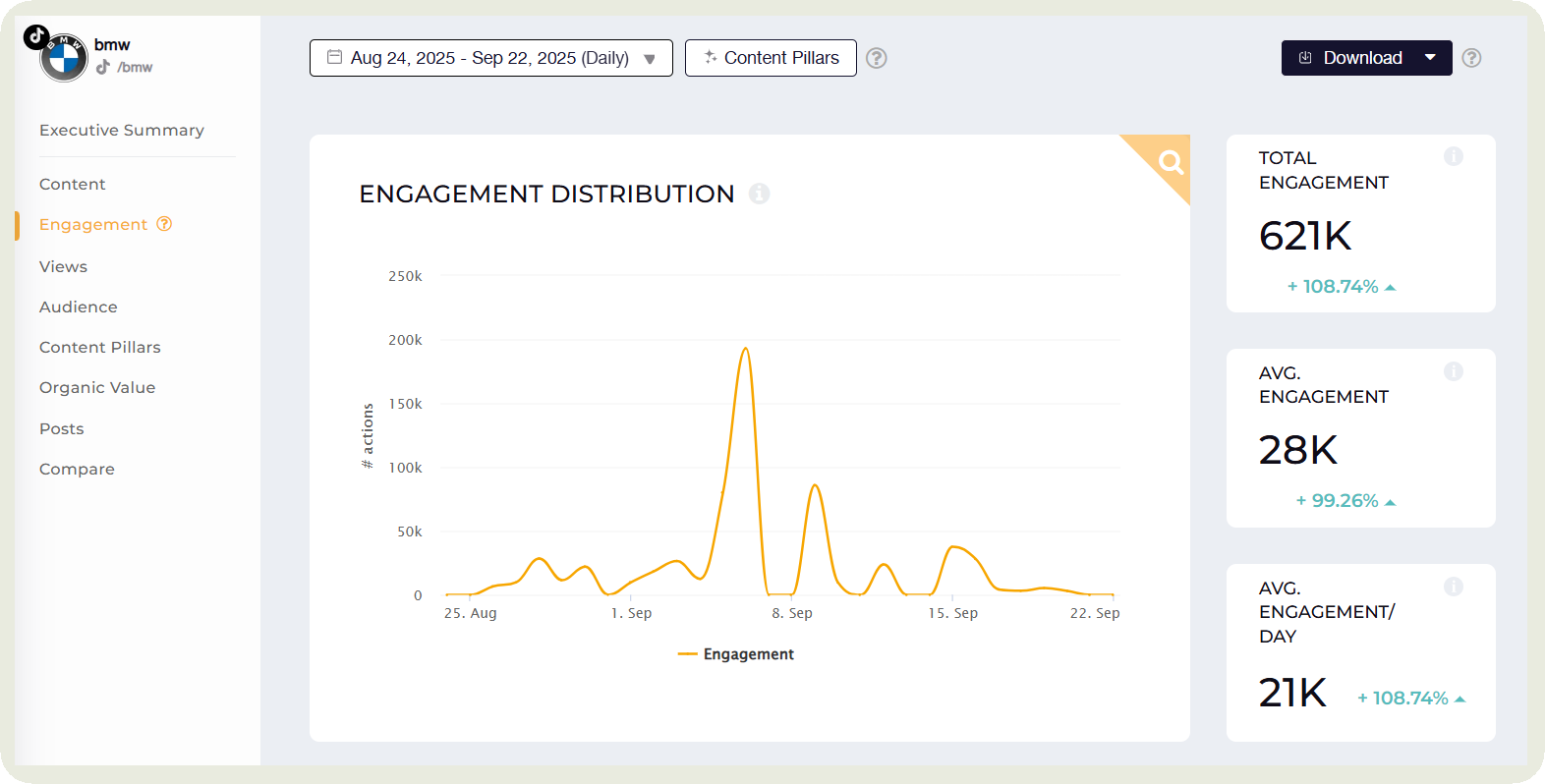
When I am running a cross-platform social media analysis, I calculate engagement rate by followers to get a better idea of which social platform is the most lucrative.
Sam mentioned video views and engagement rate as the first metrics he checks while running an audit:
Video views and engagement rate are the first indicators to look at. A consistently low engagement rate is often a clear sign of boosting, and it usually means the content simply isn’t working.
You can also spot issues just by looking at the numbers. For example, when videos plateau in the 300-1000 view range without moving further, it’s a red flag. That’s the metrics side. Beyond that, we also evaluate whether the account has a distinctive style and what kind of ‘Tok’ they’re actually aiming for, if any at all.
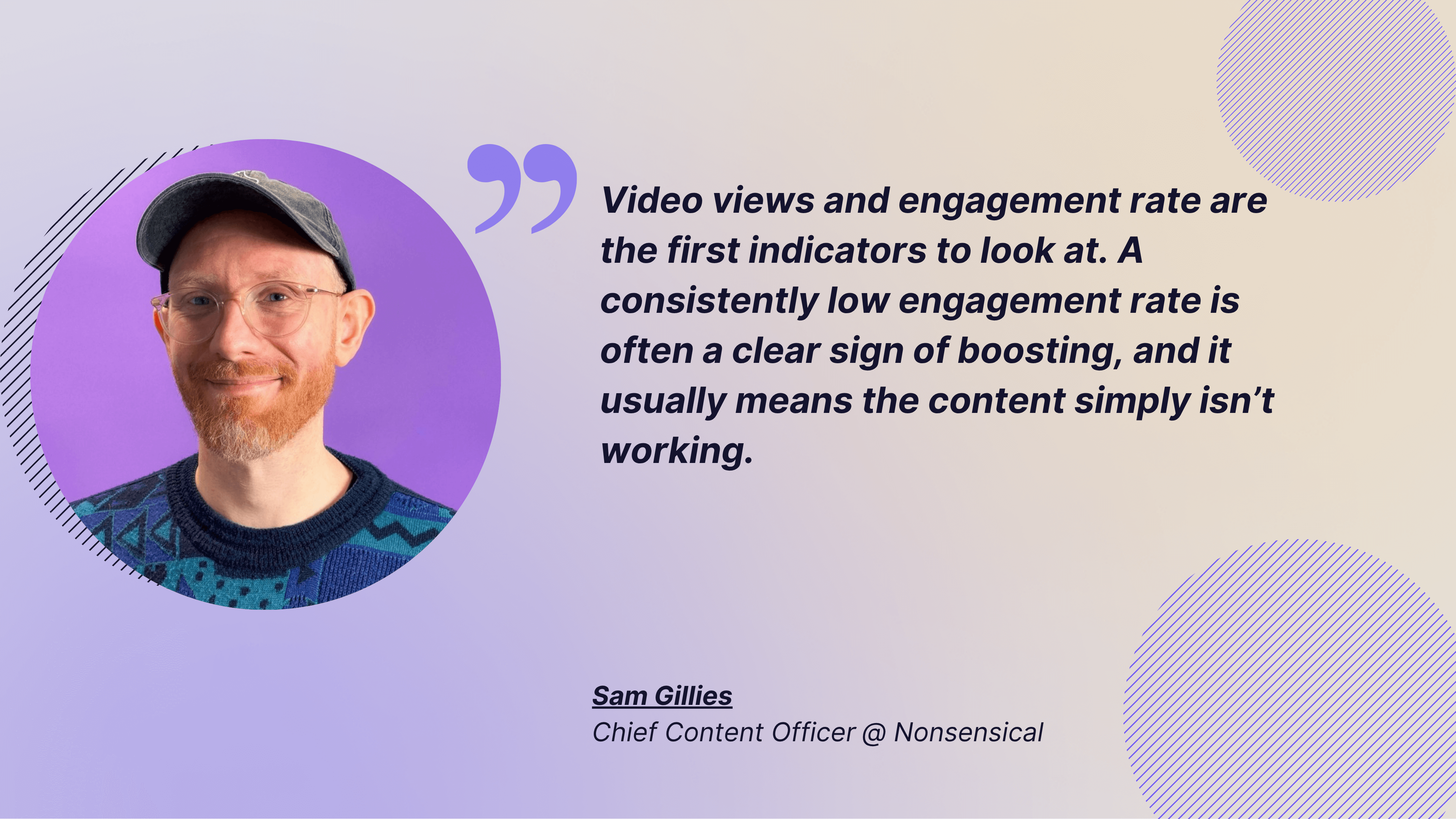
- Follower growth rate and quality: How many new followers did you gain in the recent weeks or months?
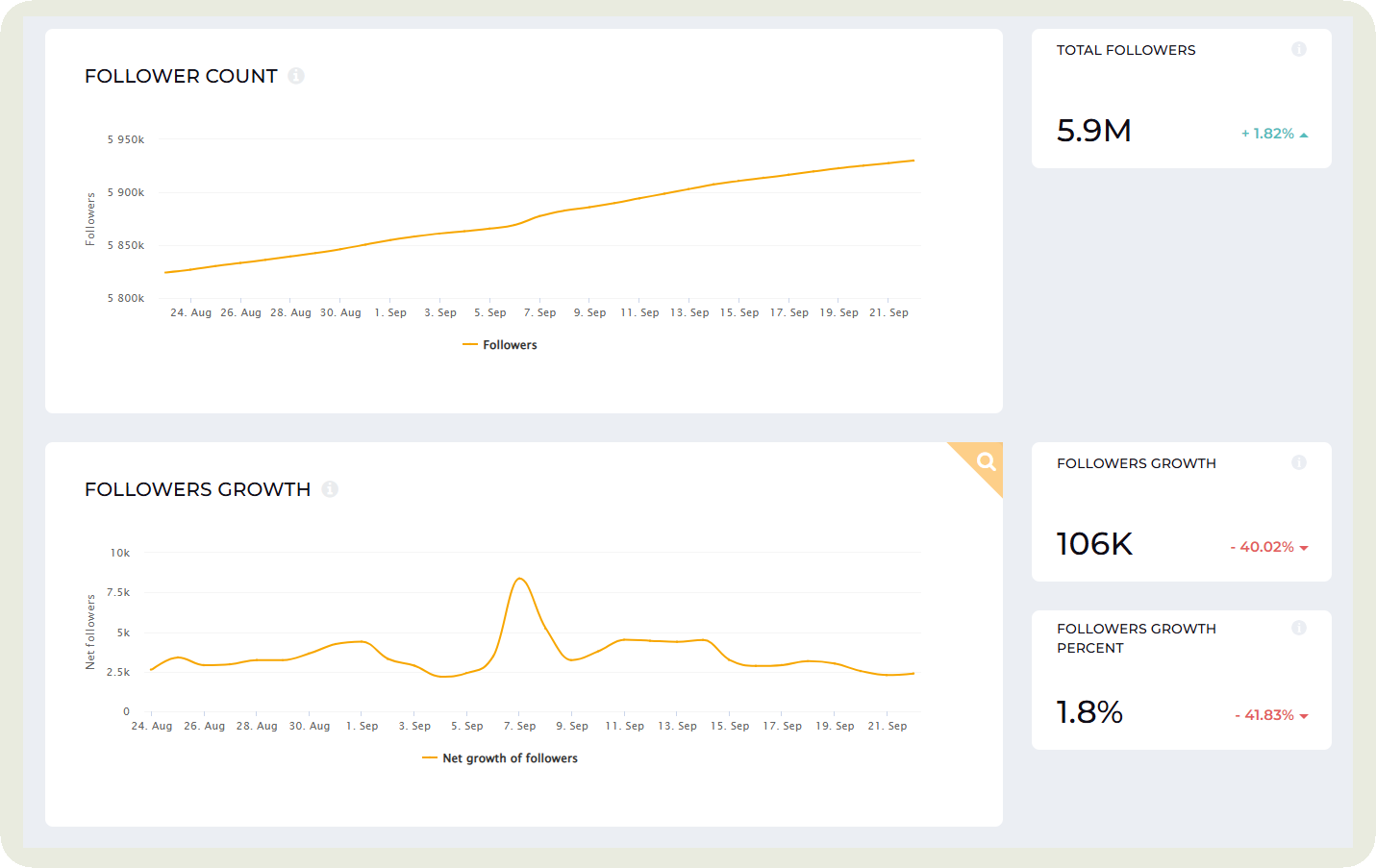
Beyond just the number of new followers, also measure the impact on engagement. Has the surge in new followers translated into more people watching your videos?
- Average watch time and completion rate: TikTok favors videos that keep people watching. Average watch time shows how long viewers stick around, while completion rate tells you what percentage watch until the end.
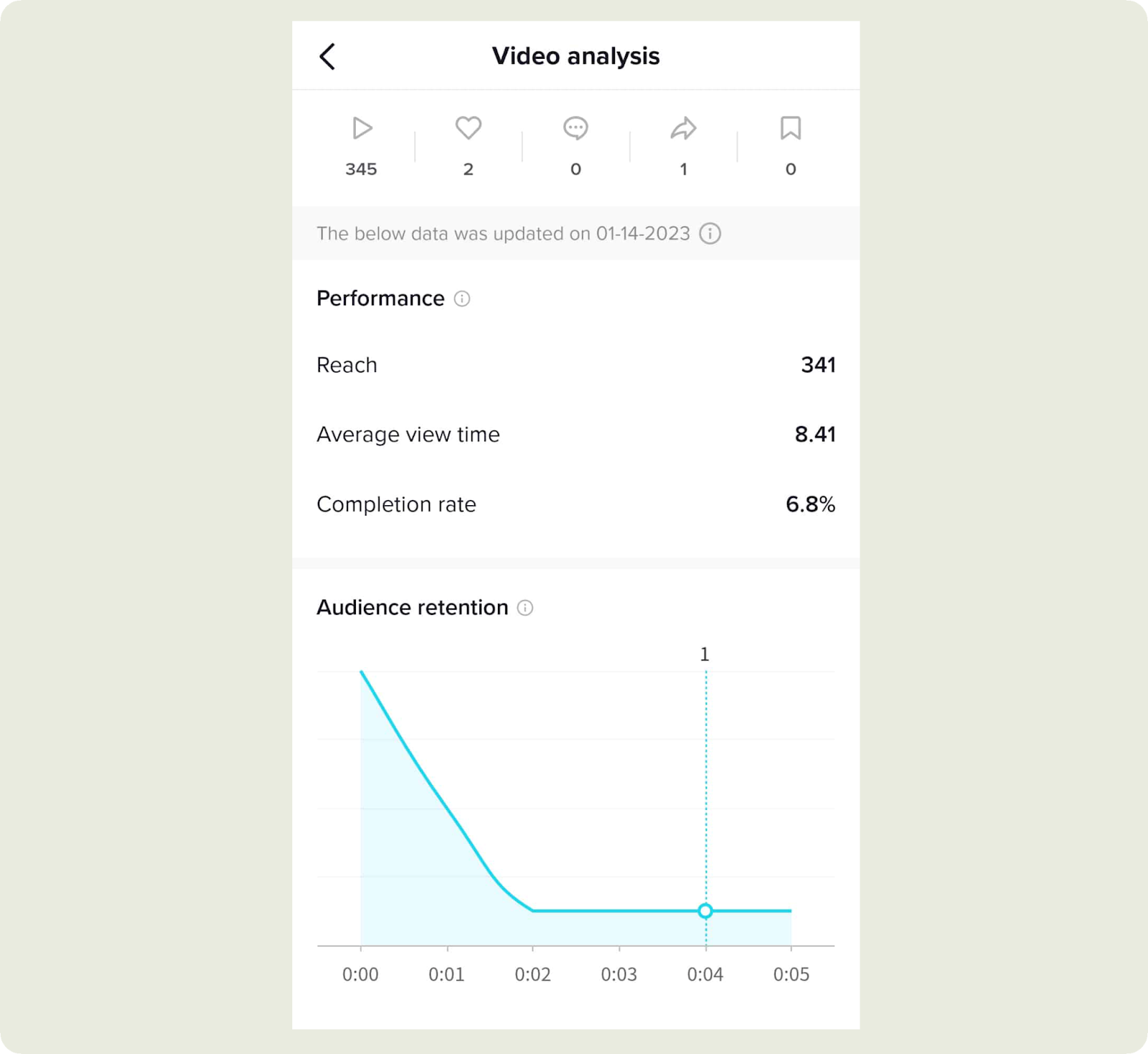
- Traffic source type: This reveals where viewers are finding your content: For You page, Following tab, profile, sounds, or hashtags. Understanding traffic sources helps you see whether your growth is organic, trend-driven, or coming from intentional discovery (like profile visits).
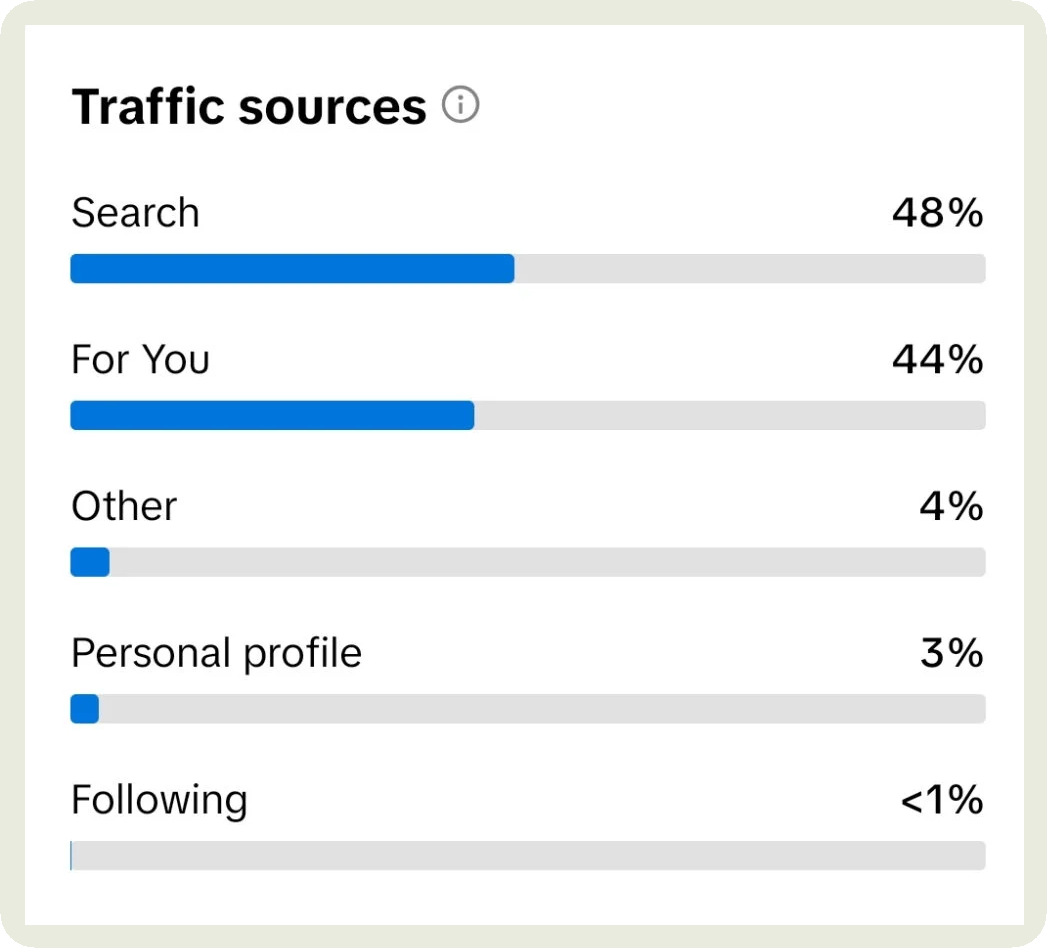
Step 3: Run a detailed content analysis
Content makes or breaks your presence on any social platform. The same rings true for TikTok. Here’s how to plan your content audit on TikTok.
View your top and bottom-performing content
Start your audit by pulling up your top and bottom-performing posts. This isn’t just a pat on the back for your best videos or a cringe session over the flops. It’s where the patterns start to reveal themselves.
Instead of manually finding this content, head to Socialinsider. Go to the Content section and scroll down to find the top and bottom posts.
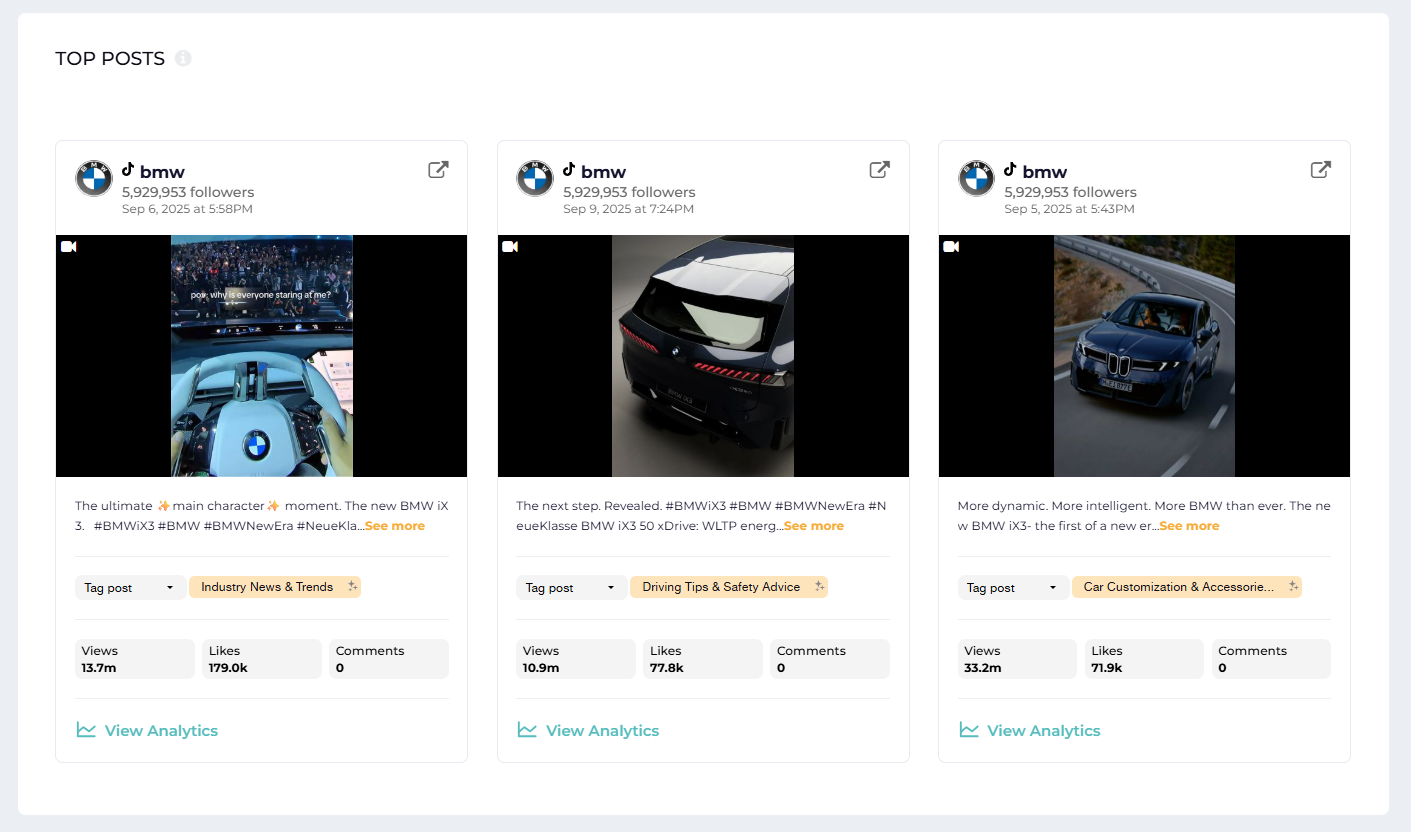
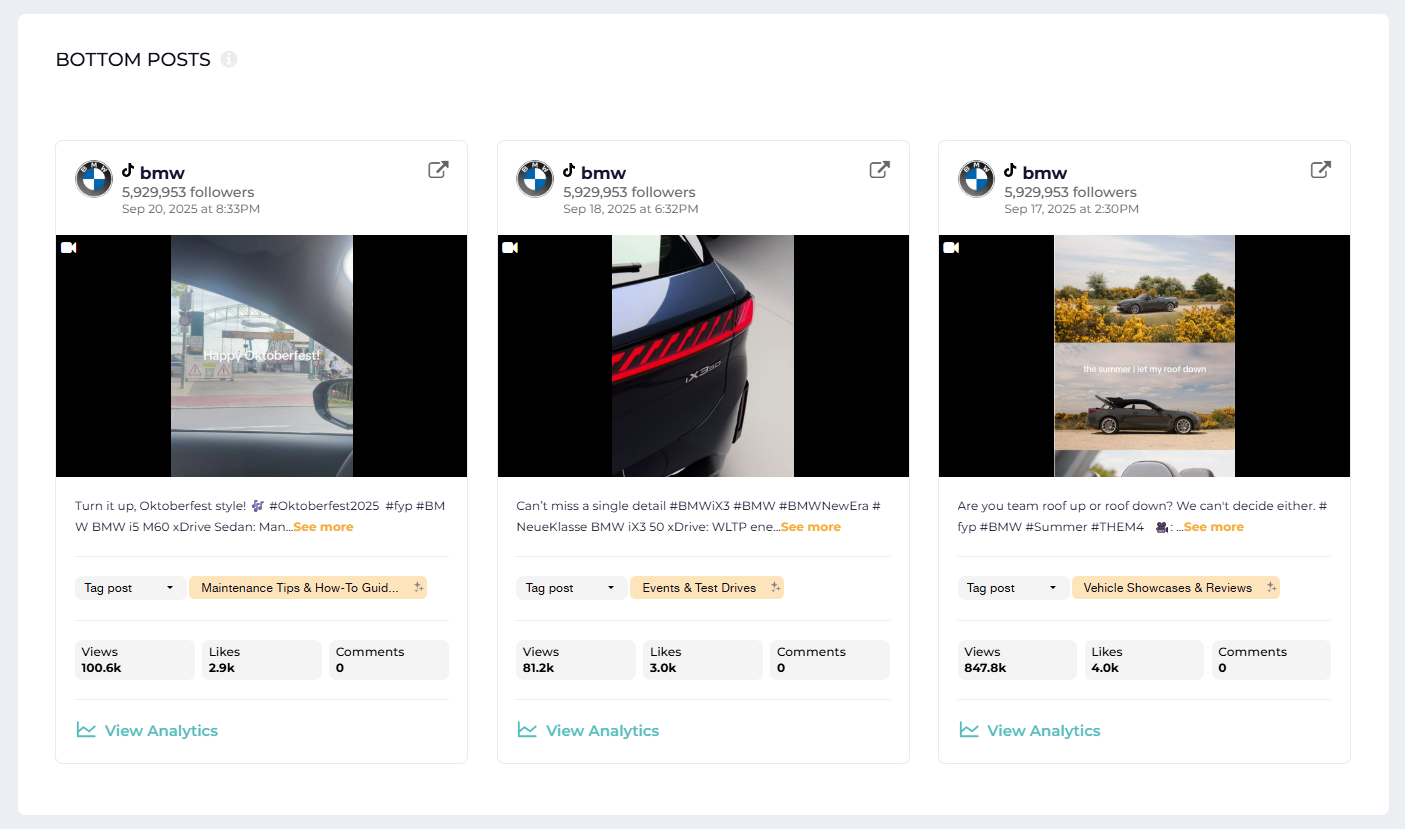
What to do next?
- Find the commonalities. Do your highest performing clips all use trending sounds? Are they shorter than 20 seconds? Did the ones that tanked have heavy text overlays or weak hooks? The goal is to spot repeatable behaviors that you can scale or avoid.
- Notice content theme-specific elements. If entertaining clips with trending audios consistently spark comments and shares, lean into that formula.
- Rethink ways to improve bottom-performing content. If your more polished, sales-driven content is dragging, don’t ditch it. Instead, rethink the delivery or mix it with elements that work for top content to keep people watching.
Categorize common content themes and track their performance
Don’t keep pouring energy into content pillars that aren’t delivering. Instead, track how each theme performs and let the data guide you.
Socialinsider’s AI-generated content pillars make this simple by showing you which themes actually generate the most engagement.
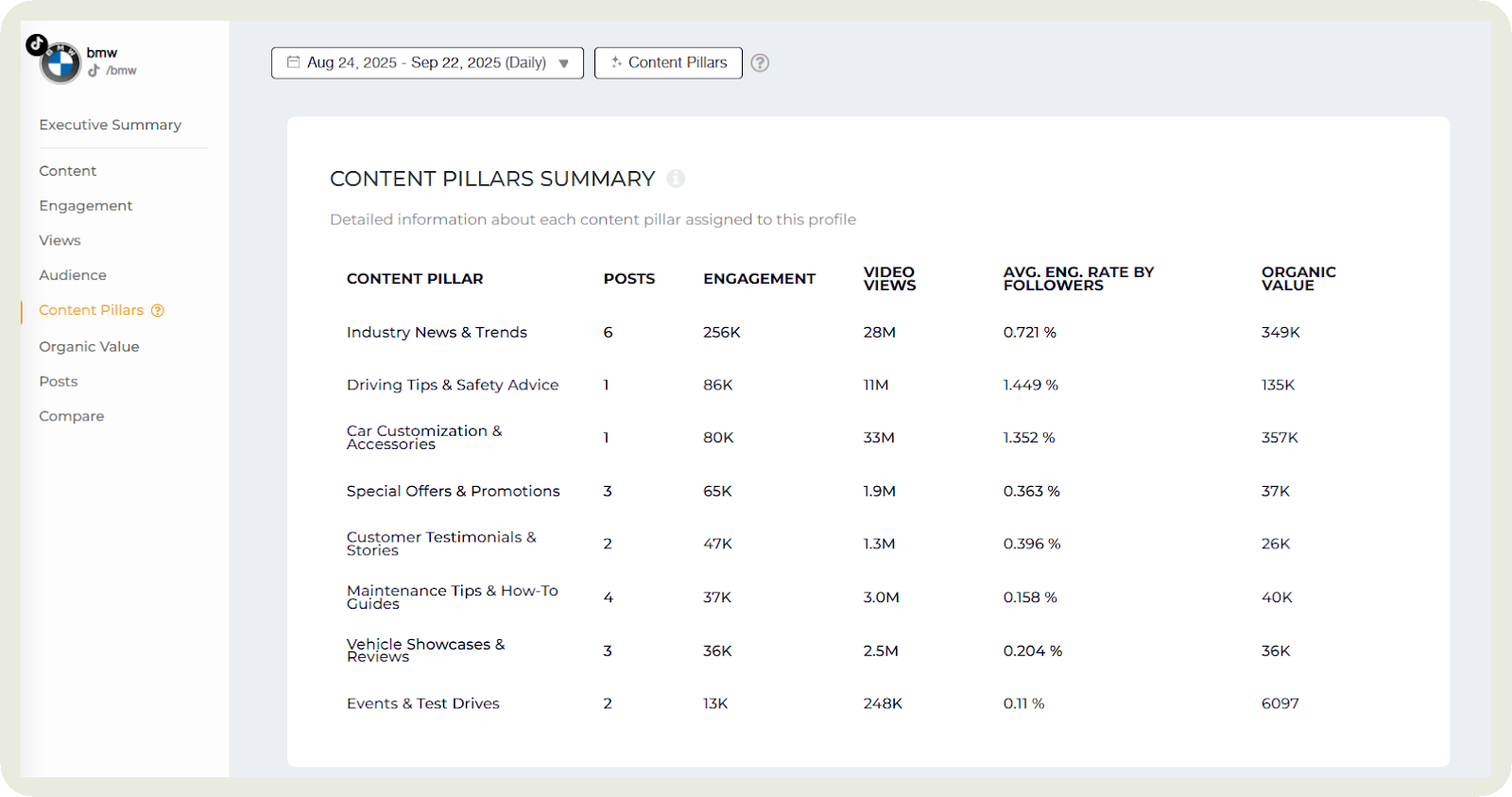
Laviet Joaquin, who leads the marketing team at TP-Link, does the same -
“Identify the content categories attracting the highest levels of interaction. Search for recurring elements in posts that resonate well. At TP-Link, we observed that tech how-to guides and product demonstration videos garnered the most attention. So we scaled our efforts on creating similar videos.”
If you’re experimenting with multiple themes – humour, educational, or behind-the-scenes – categorize them by tagging the posts in Socialinsider.
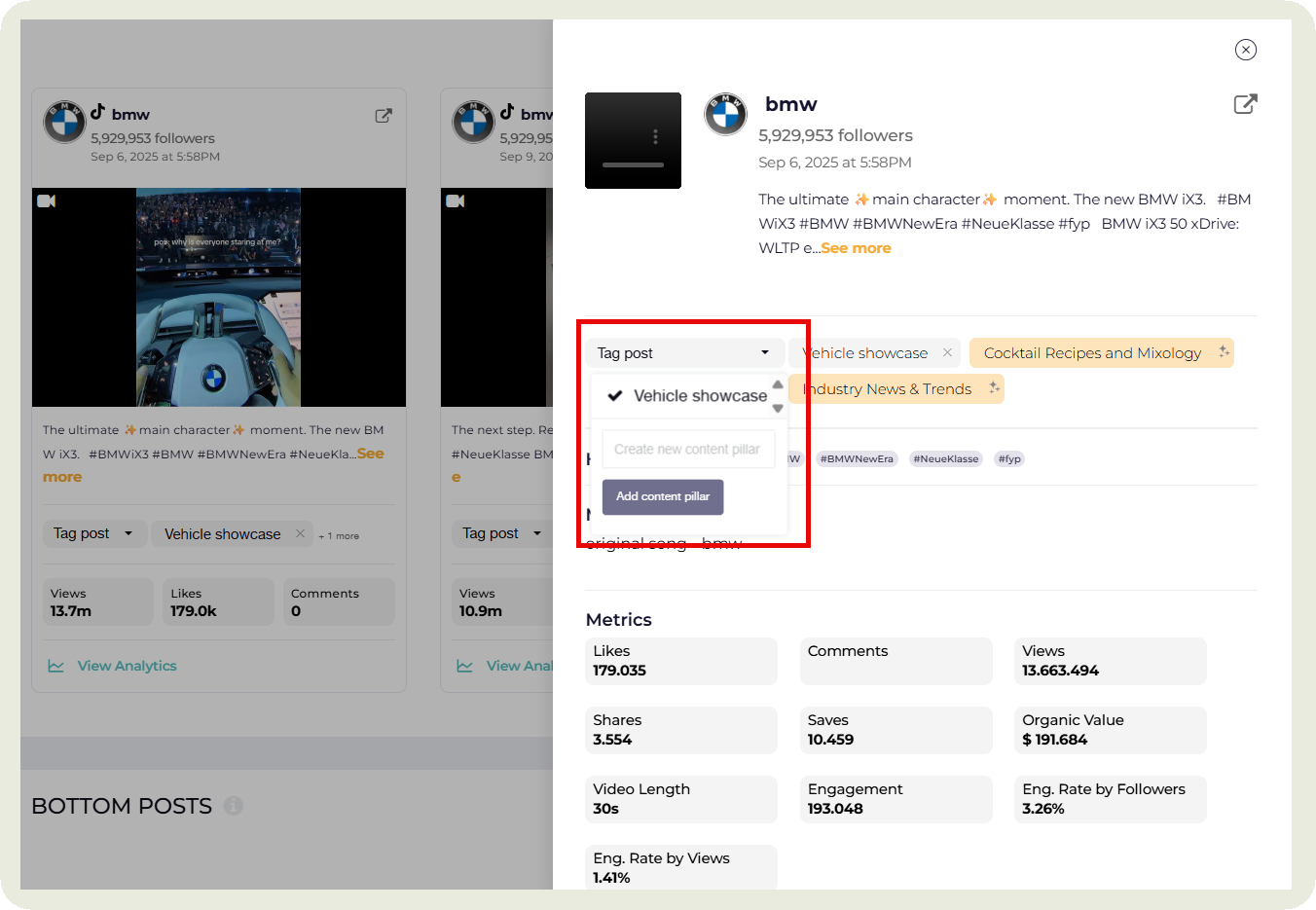
Once all your posts are tagged, you can automatically get this pillar’s engagement metrics in the Content Pillars tab.
This makes it easy to double down on what works and redirect resources from what doesn’t.
Check for content frequency and posting times
How often are you posting videos on TikTok? Is it aligning with your goal? For example, if your goal is to gain followers, you may need to increase posting frequency to stay visible on the For You page. You may even want to see how to divide content frequency for each format.
According to our TikTok benchmarks report, smaller TikTok accounts publish more carousels. If you’re one, you may want to experiment with increasing the frequency of these carousels.
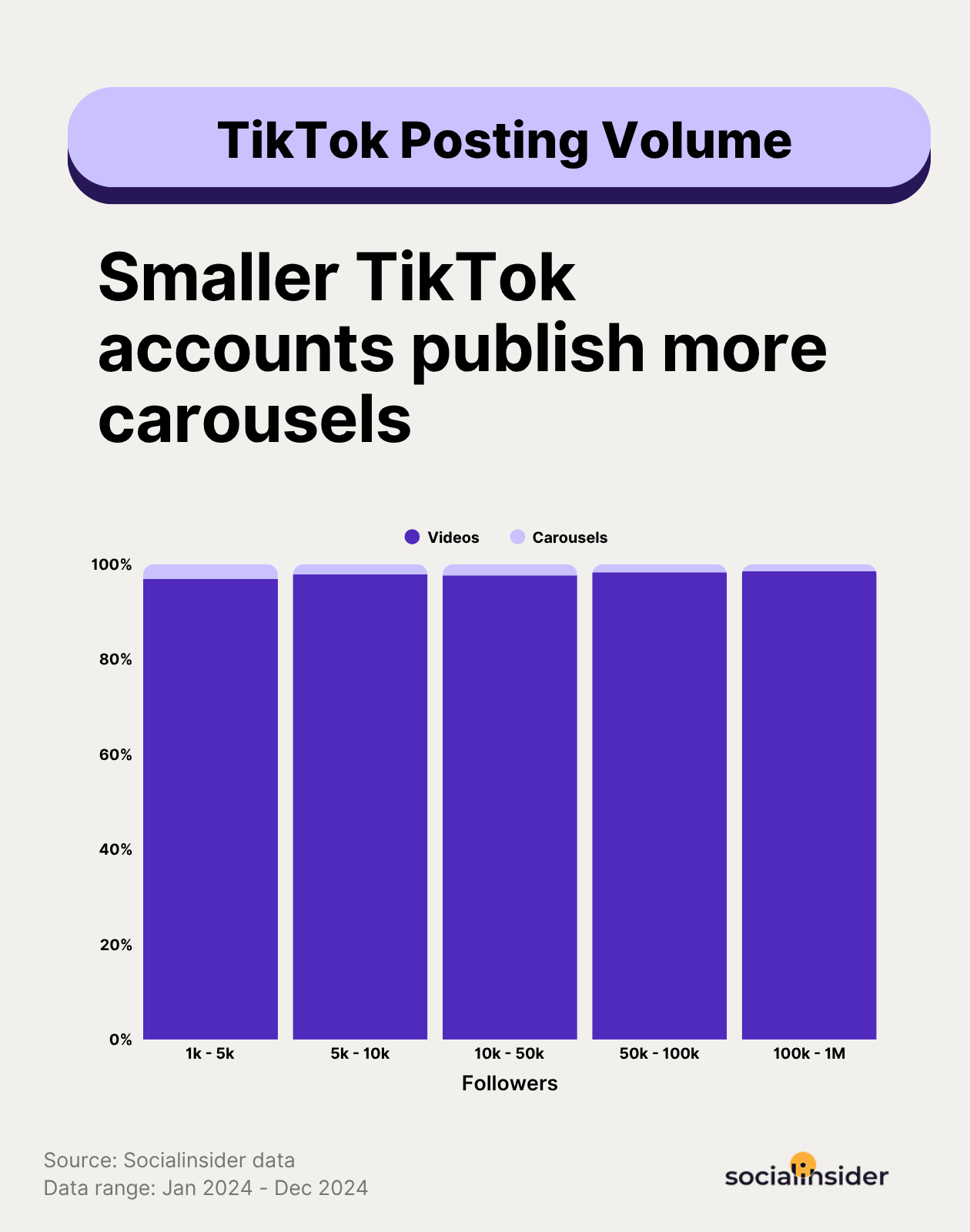
Frequency is only half the story. Timing matters too. Are you posting when your audience is most active, or are your videos getting buried in the scroll?
You can use TikTok’s native analytics to see when your followers are active.
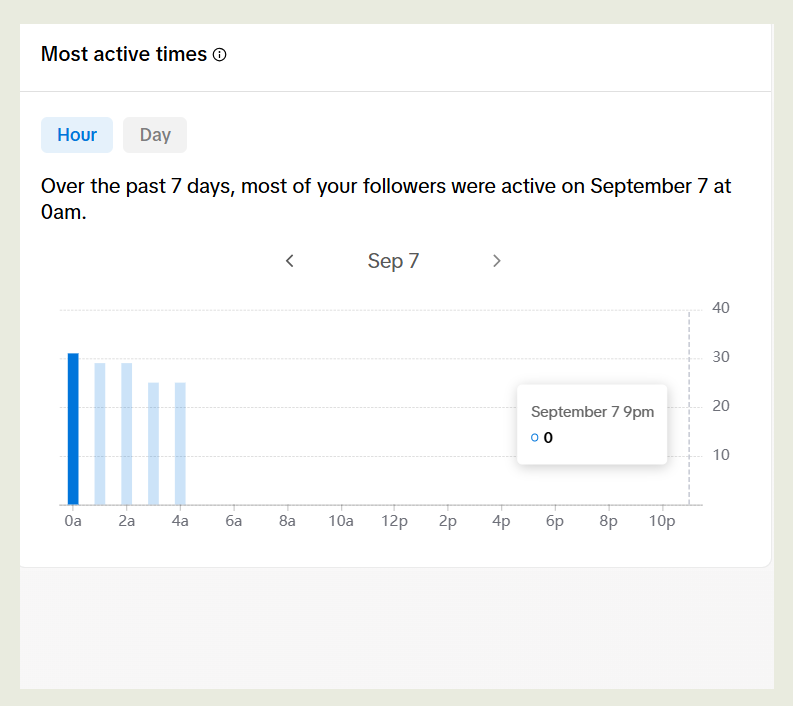
Or you can use Socialinsider, which tracks your historical posts (beyond the last 7 days) to suggest the best posting times based on engagement.
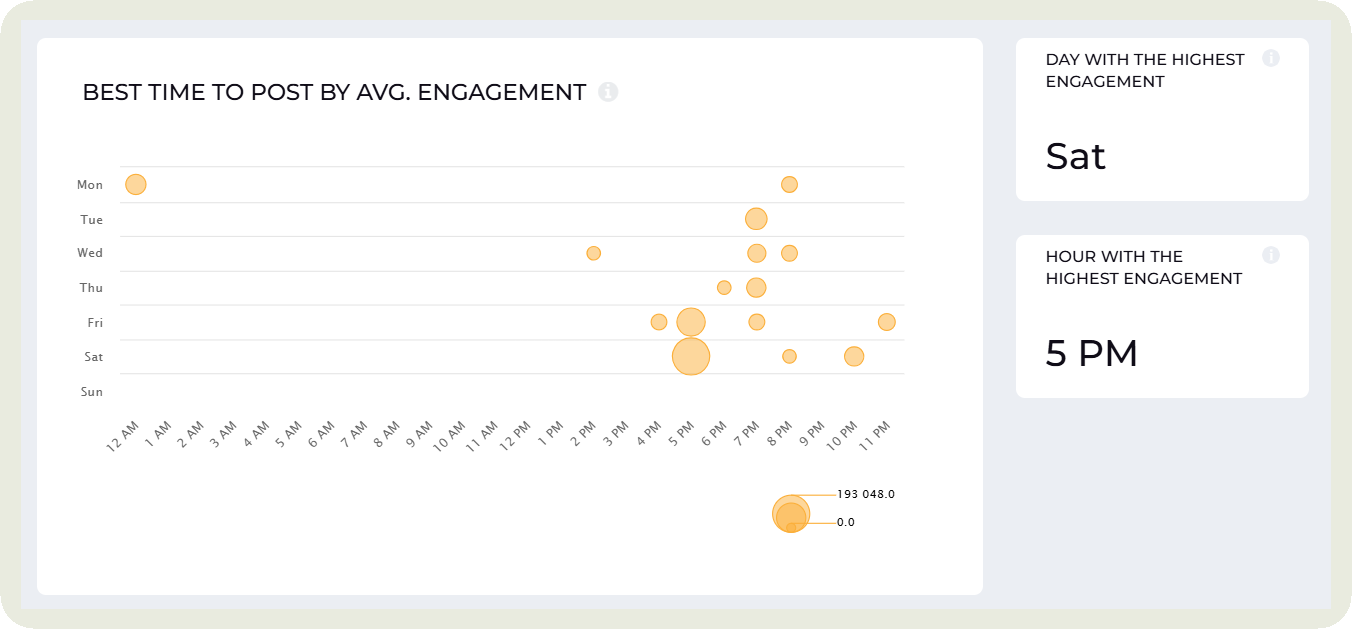
Run post-level diagnostics
Once you have tracked overall content performance, it’s time to dig deep into individual content pieces. Here’s how to go about it.
- Check for hashtag, CTA, and caption effectiveness: Are you successfully able to direct the audience to click on links, comment, share, and take the action your CTA talks about?
I use Socialinsider’s keyword or advanced query feature to check for effectiveness. For example, I filter captions with the keyword ‘comment’ to see if posts that include lines like ‘drop your thoughts in the comments’ actually succeed in sparking more comments.
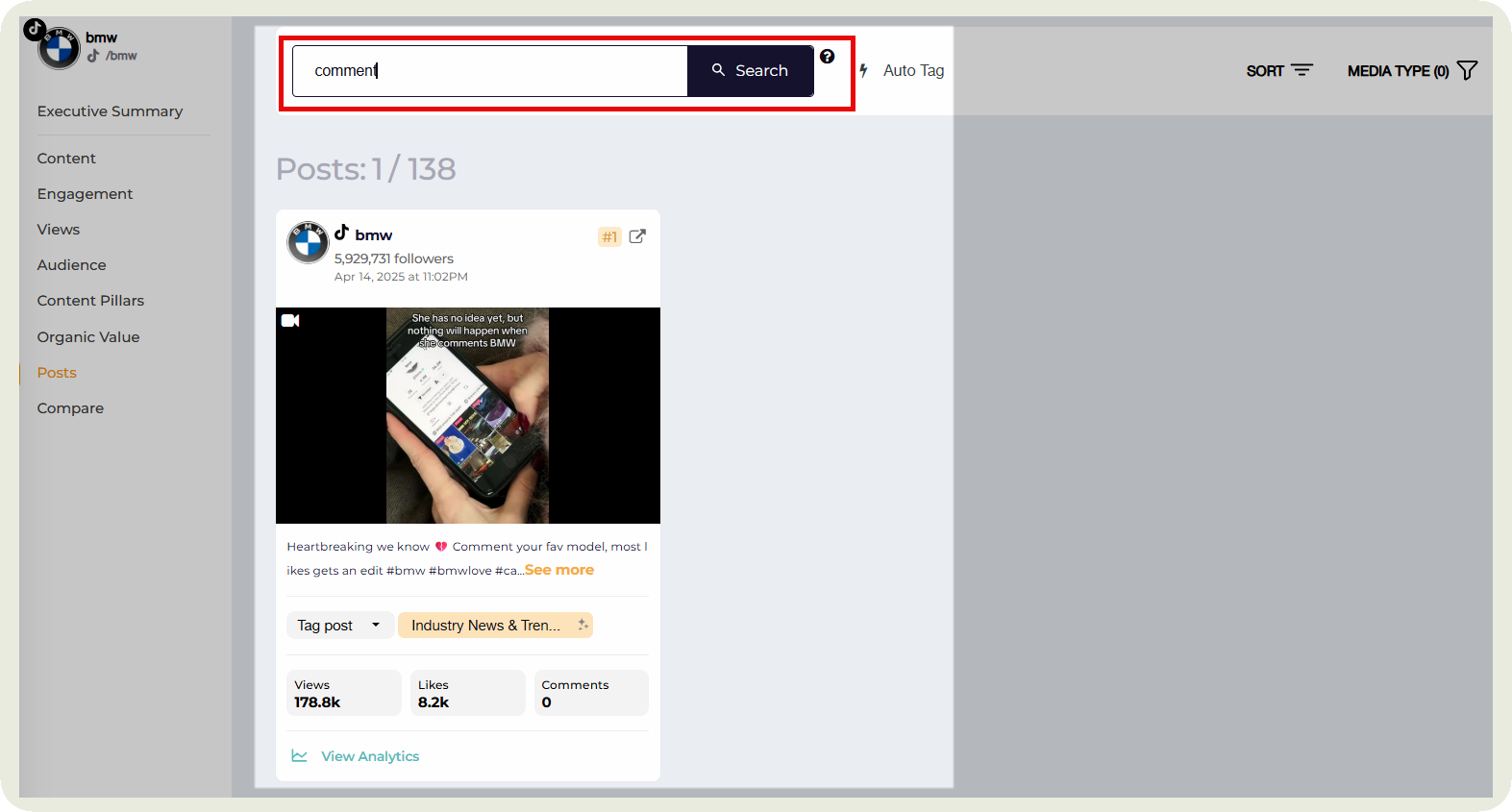
- Engagement type breakdown: What kind of posts get more saves/shares? Which content pillar gets a lot of likes? This will help you categorize content not just by theme, but by the type of value it delivers.
Say, you’re focusing on increasing brand awareness. You can sort your posts by views to check which kind of videos get watched by more people.
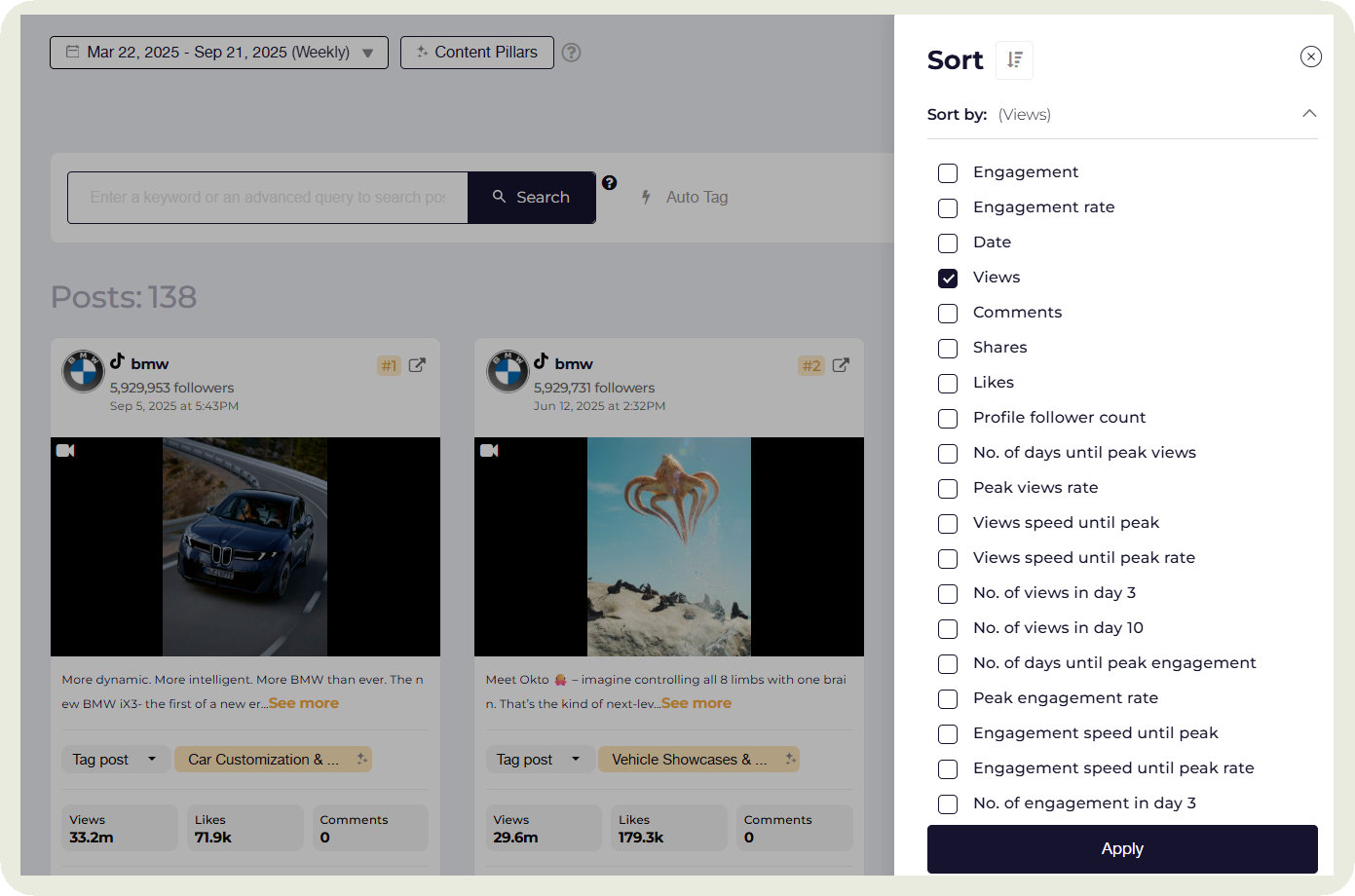
You can then prioritize these kinds of posts in your content mix.
A good audit should highlight what a brand needs to do more of and what to cut back on. In most cases, brands already know when their account isn’t performing well. Raw numbers alone don’t add much to the story.
What really matters is the qualitative narrative around the content. Is it consistent? Does it feel unique? Does it integrate the brand naturally? For most, the honest answer is ‘no.’ That’s why the real value of an audit comes from digging deeper into the business setup, figuring out how they can create content that feels authentic, distinctive, and genuinely their own on TikTok.
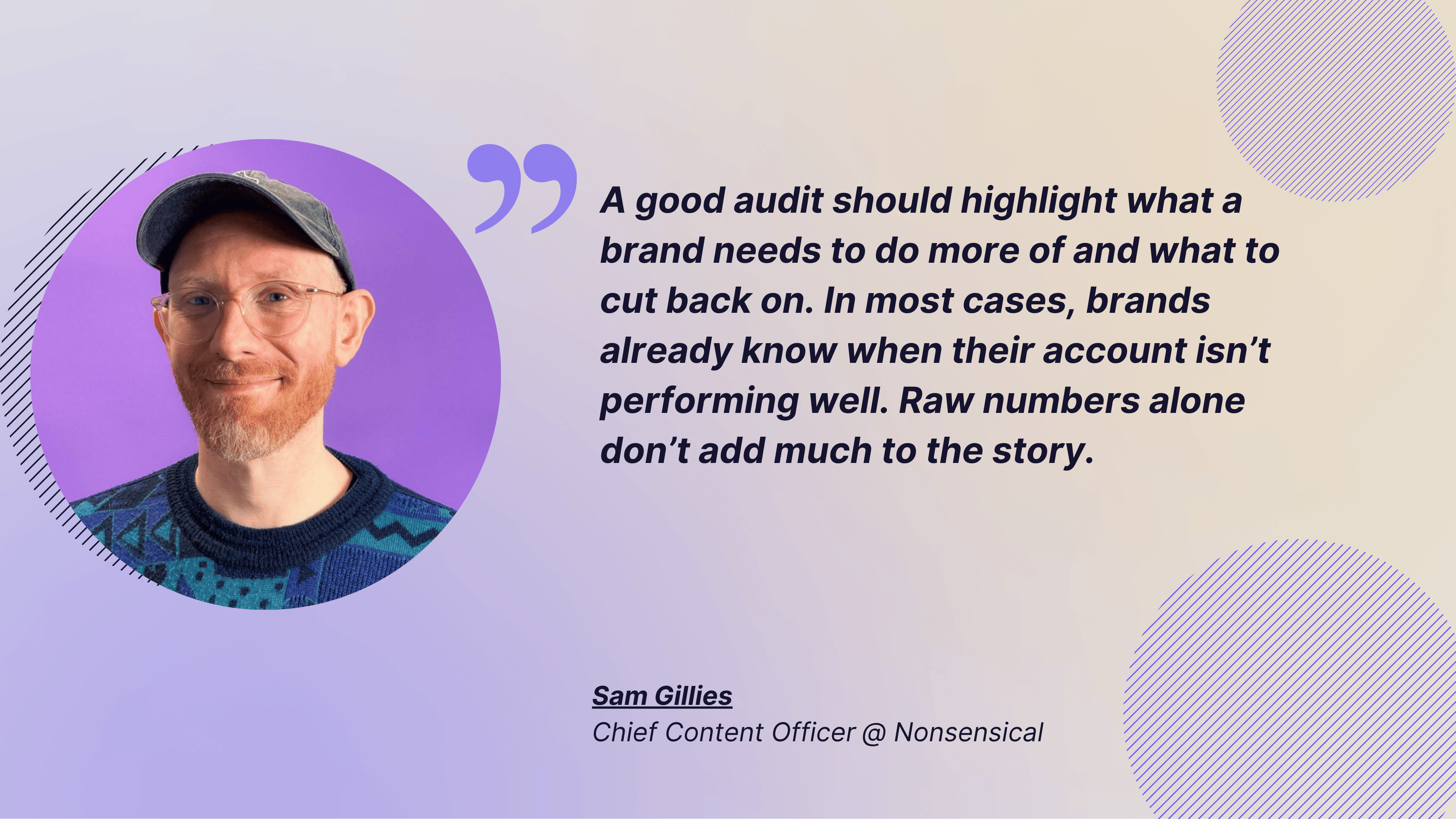
- Track sound and trend adoption: Review your top posts to see if trending audios boosted engagement compared to original ones.
I also use TikTok’s Creative Center to spot emerging trends and check if competitors adopt them faster.
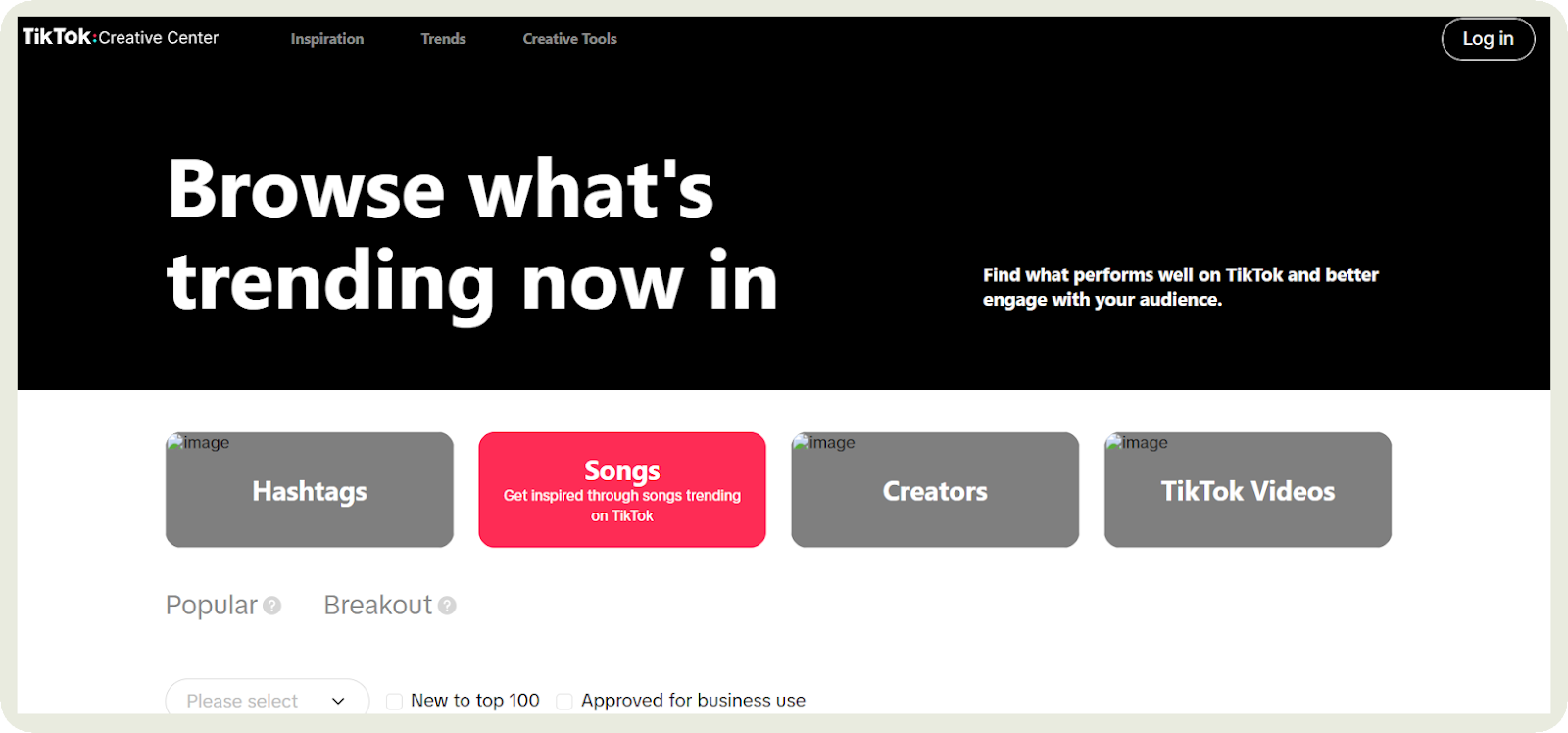
Post this analysis, tag and document which sounds resonate most with your audience.
Here’s how Jason Hennessey, founder and CEO of Hennessey Digital, audits for trending audio on TikTok –
“We examine which sounds or music tracks have driven higher engagement in the videos. By identifying trending sounds, we can determine if incorporating these sounds aligns with increased views and interaction. However, we also ensure that the chosen sounds resonate with our brand’s identity and message. Consistency in sound selection helps maintain brand recognition and reinforces our client’s brand image among TikTok users.”
- Check for retention patterns: Dive into your native analytics and study where viewers drop off. Is it in the first three seconds because your hook didn’t grab attention? Or halfway through because the pacing dragged and you lost momentum?
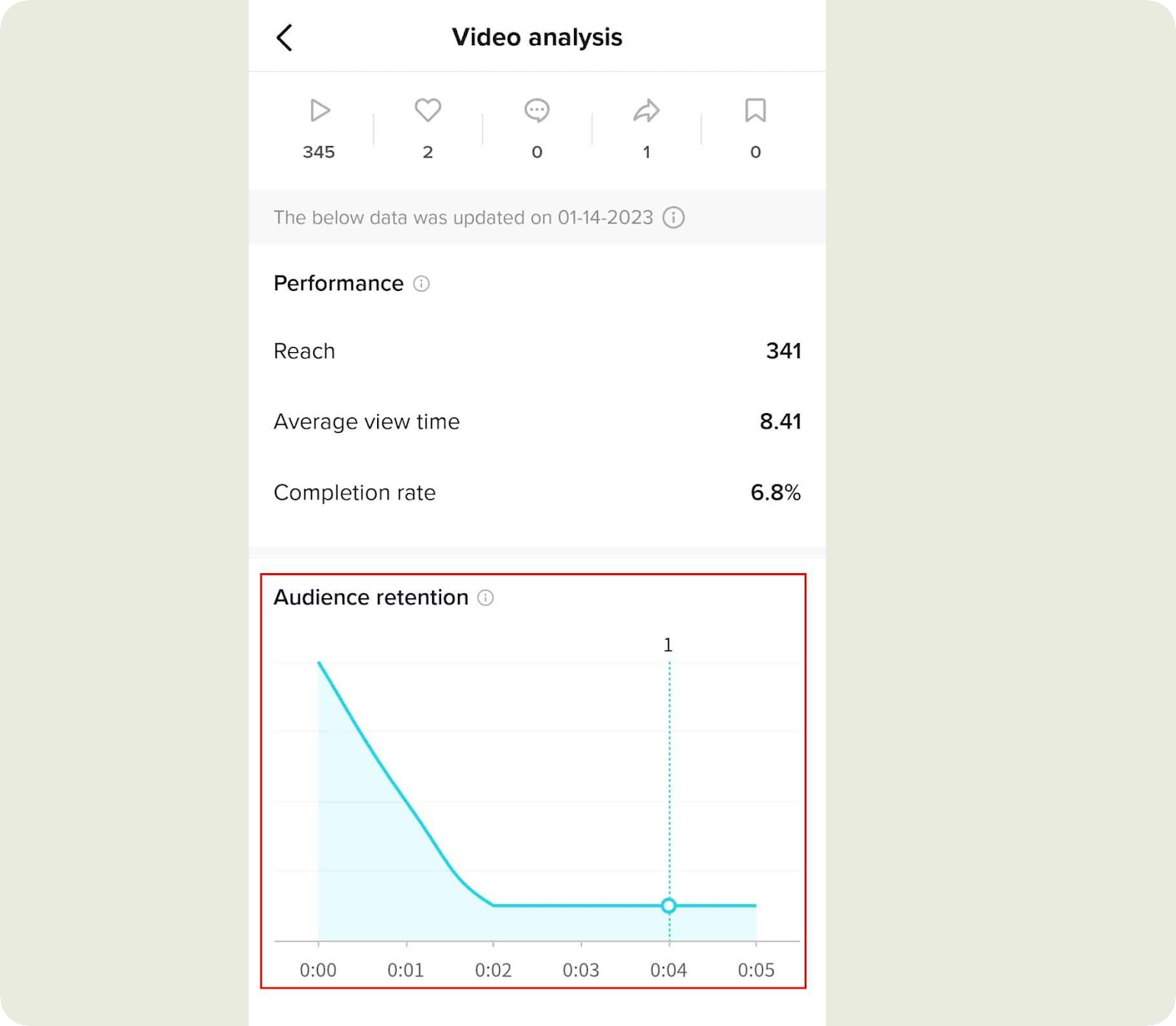
Use these insights to experiment. Strengthen your openings with bold text, questions, or quick cuts. Add transitions that keep energy high and make your storytelling flow more naturally.
Step 4: Conduct a TikTok audience audit
A TikTok follower audit gives insights about your audience demographics, how they engage with you, and whether you need to pivot your content strategy to attract relevant audiences.
Start by looking at your demographics in TikTok’s native analytics.
Check the gender split and top countries/regions to see whether your TikTok audience aligns with your business’s target market.
Next, I monitor the follower growth rate on TikTok — Is my account growing steadily? Am I seeing a healthy and steady growth rate?
When running a deeper audit, I like to compare growth rates over similar periods. For instance, you can measure how your holiday campaigns influenced TikTok follower growth this year versus last year, and see whether your strategy is gaining momentum or needs a rethink.
You can use the Compare feature in Socialinsider to get these insights.
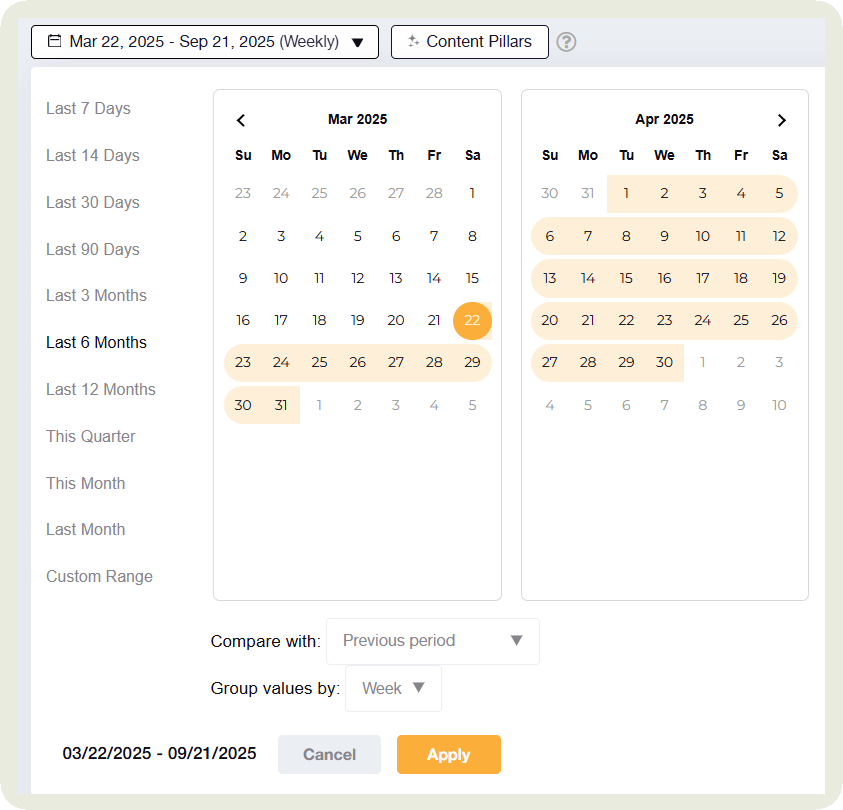
Step 5: Analyze competitor strategies and perform benchmarking
A competitor analysis on TikTok highlights what rivals are doing differently, from trend adoption and posting cadence to content themes, so you can spot gaps, borrow what works, and outsmart them on the platform.
Narrow down your top competitors and follow this three-step process that I use.
- Get an overview of how your competitor is doing. Use Socialinsider’s Key insights summary to get this in an instant.
For example, I can see here that BMW has increased content publishing in the last month and has seen increased engagement.
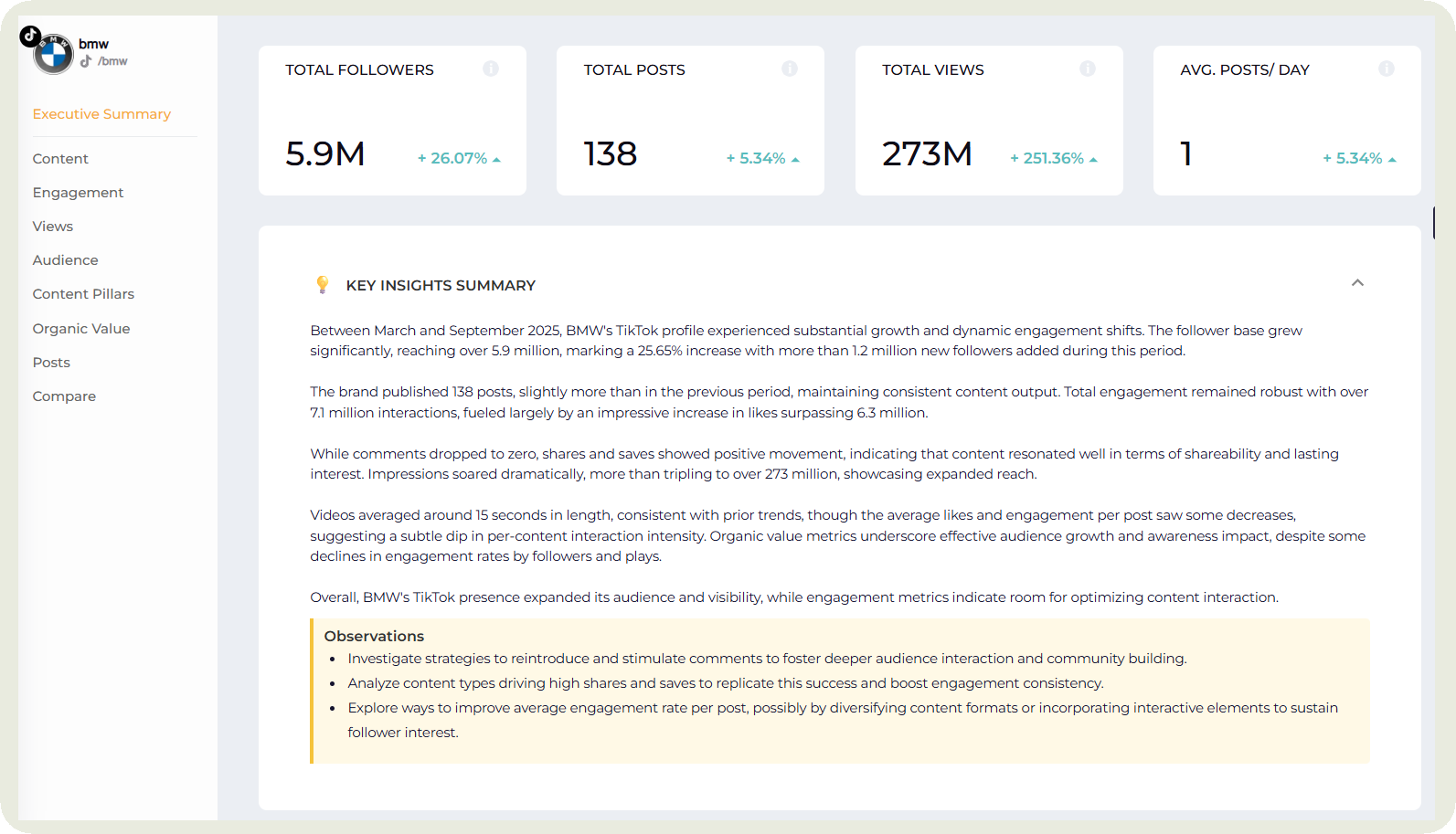
- Compare your performance to your competitors. In this step, you can compare content mix distribution, posting frequency, and strategies.
I start by checking the content pillars. To do that, I use Socialinsider to see how HudaBeauty and Rare Beauty compare on each content pillar, along with their best posts for each pillar.
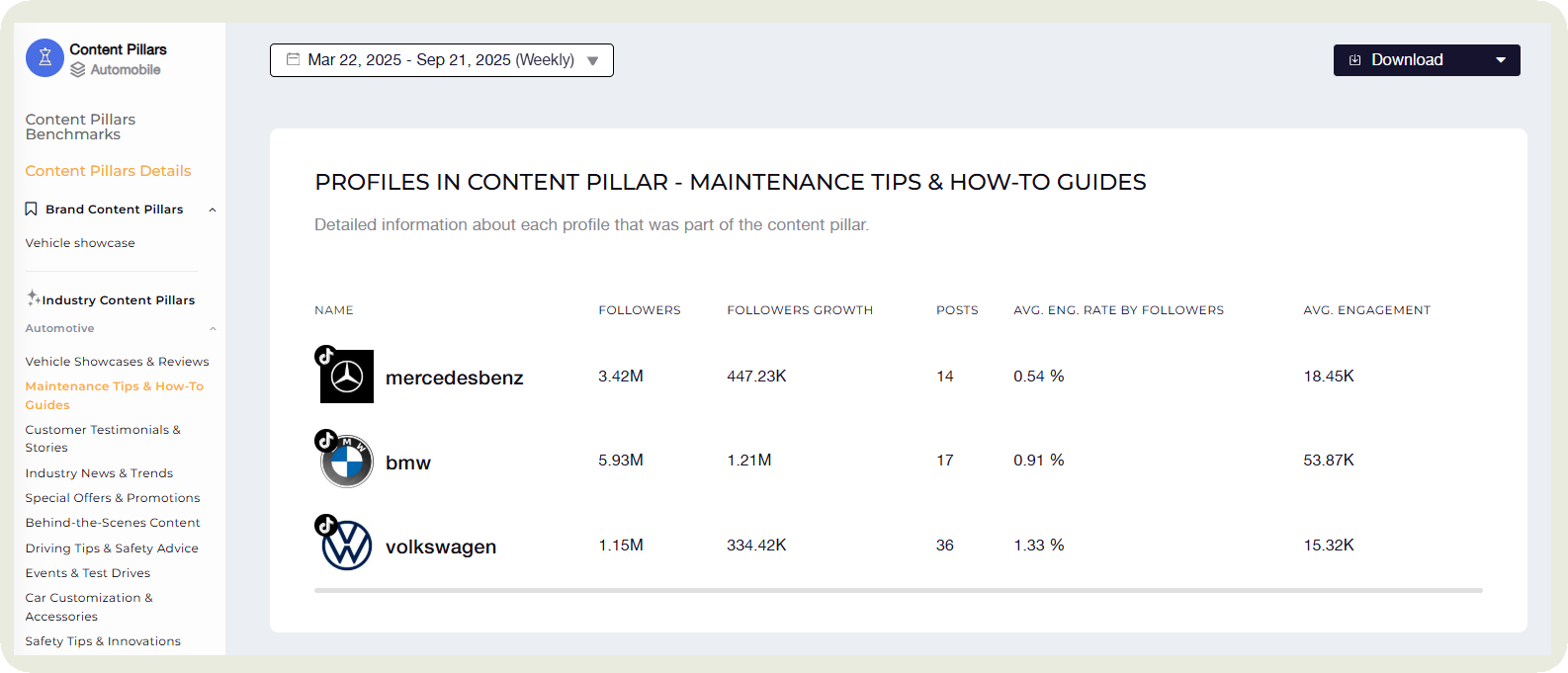
This lets me know how my competitor approaches each content pillar and their pillar-specific strategies.
Pay close attention to their tone, creative style, and storytelling elements that give them an edge.
- Compare relevant metrics and KPIs. Which metrics are relevant to your audit goal? For example, if you’re looking to increase engagement, shortlist social media metrics like engagement and the average engagement rate by followers.
See how your competitor’s metrics compare to yours.
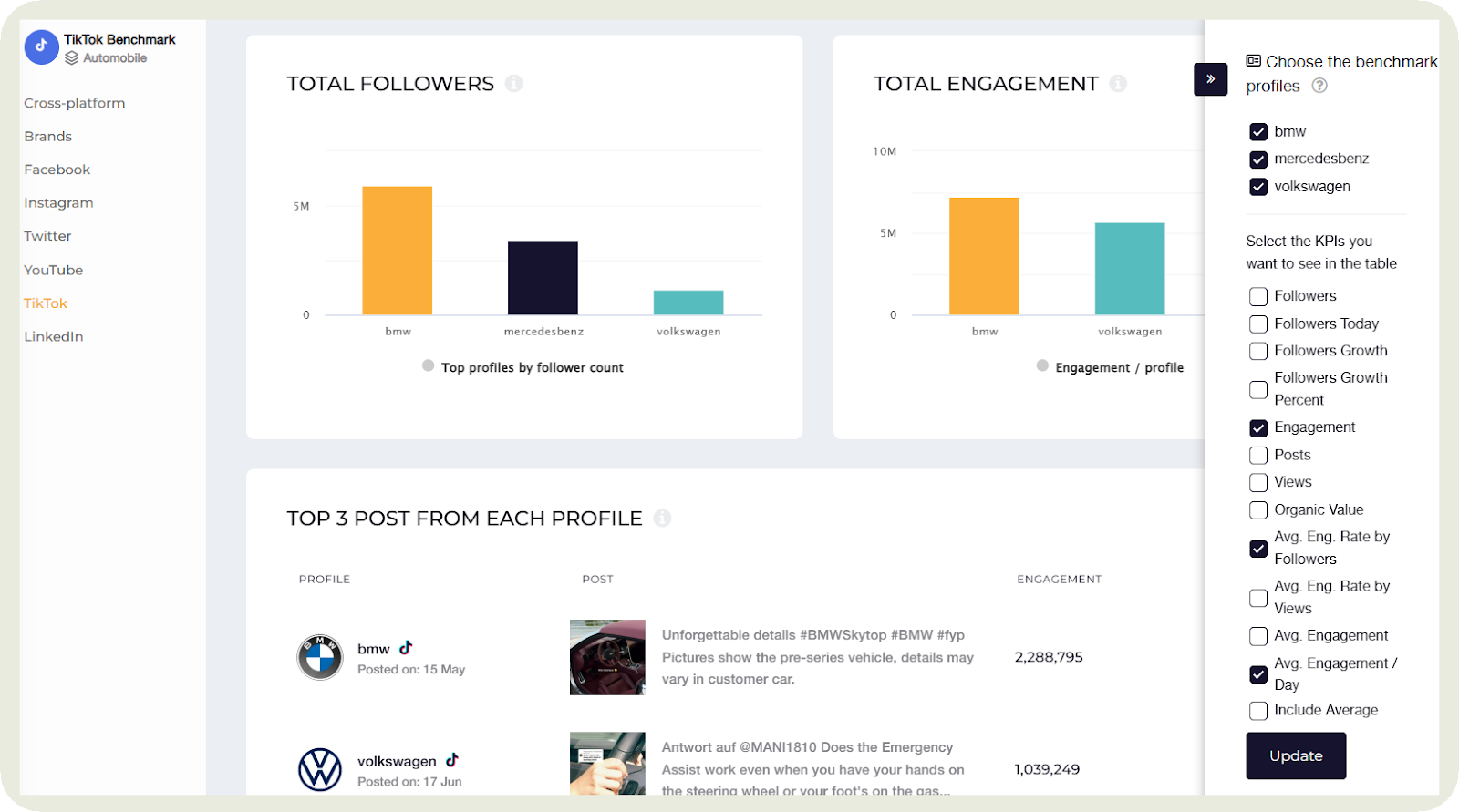
Step 6: Collate findings and make an action plan
While it may not look like it, this is the most important step of a TikTok audit. All your TikTok analysis goes to waste if you can’t optimize your TikTok marketing strategy based on the insights.
Start by sorting your findings into two piles: quick wins and big bets. Quick wins are the low-hanging fruit, like swapping weak CTAs for stronger ones or posting at better times. Big bets are the larger strategy shifts that need more testing but could pay off long term. For example, introducing a new content pillar or changing the way you narrate your customer stories.
Next, pick two or three experiments you can actually commit to. Maybe it’s posting two extra videos each week, trying out more behind-the-scenes content, or testing trending sounds within your niche. Keep it focused.
Attach KPIs to every experiment so success is crystal clear. Don’t just say ‘boost engagement.’ Say ‘raise engagement rate by views by 10% in the next month.
Finally, document your findings. Build a TikTok playbook with trends, hooks, captions, and sounds that worked and insights from your competitor analysis. This becomes your team’s creative cheat sheet, ensuring good ideas don’t get lost in the scroll.
Tools to run a TikTok audit effectively
There are two options when it comes to TikTok audit tools. We’ll explore each one and understand its pros and cons.
Native TikTok analytics
TikTok hands every creator a built-in analytics dashboard right inside the app. I’ll admit, I love how easy it is to access. It’s free, straightforward, and gives you a quick pulse check on your account.
When I want to see how a video performed, I can instantly track views, follower growth, and engagement.
What I use most often are the retention metrics. Average watch time and completion rates tell me whether viewers stuck around or bailed halfway through.
I also check when my followers are most active so I can post at the right moment instead of guessing.
But here’s the catch. The data window is short, content categorization is too basic, and if I need competitor insights, I have to turn to a third-party tool, which brings us to the next option that I mix in with native analytics.
Third-party analytics tools like Socialinsider
When TikTok’s native analytics stop short, I lean on Socialinsider. Here’s why it makes for a great TikTok analytics tool:
- Historical data beyond 60 days: I can track and compare performance across months or even years, which is impossible in native.
- Content pillars and tagging: I tag posts by themes (educational, behind-the-scenes, product-focused) and instantly see which pillars drive the most engagement.
- Advanced metrics: Engagement rate by views helps me measure creative quality more accurately than likes alone.
- Competitor analysis and benchmarking: I get to see how my account stacks up against others in the same space.
- Automated reports: Clean, exportable visuals make it easy to share findings with my team or clients without extra formatting.
Time to turn your TikTok audit findings into lasting wins
As a social media strategist, it’s all too easy to get buried in the daily grind of ideas, edits, and endless scrolling for the next big trend. In that rush, a TikTok audit often takes the back seat. The hard truth? That single step is usually what flips your strategy from guesswork to growth.
When you turn audit findings into action, everything becomes sharper. You double down on the content pillars that truly resonate. You post when your audience is most engaged instead of when it’s convenient. And you pick trends that fit your brand rather than chasing every shiny fad.
The best part is you don’t have to spend hours pulling spreadsheets or piecing things together. With a free trial of Socialinsider, you can run a full TikTok audit quickly and focus your energy on applying the insights where they matter.
FAQs about TikTok audit
1. How to audit a TikTok account to grow followers?
To audit your TikTok account for follower growth, begin by reviewing your top-performing posts to see which formats, sounds, and themes capture the most attention. From there, check when your followers are most active and adjust your posting times to match. Next, dig into retention metrics to be sure your hooks keep viewers watching. Finally, compare your profile with competitors and focus on content pillars that consistently drive reach and engagement.
2. How often should I run a TikTok audit?
How often you run a TikTok audit depends on your goals, but a good rule of thumb is every quarter. This gives you enough data to spot meaningful trends without letting bad habits build up. If you’re running short campaigns or experimenting with new formats, a monthly mini-audit can help you pivot quickly. Regular check-ins keep your strategy fresh and aligned with audience behavior.
Analyze your competitors in seconds
Track & analyze your competitors and get top social media metrics and more!
You might also like
Improve your social media strategy with Socialinsider!
Use in-depth data to measure your social accounts’ performance, analyze competitors, and gain insights to improve your strategy.


